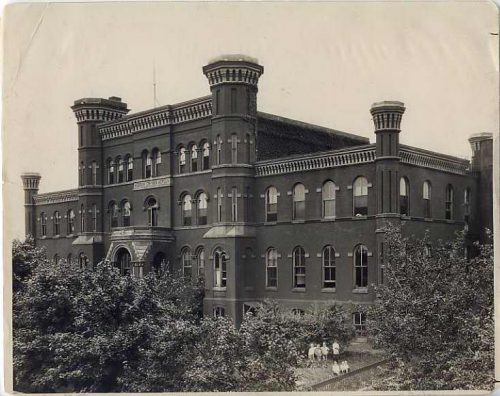Poor Man’s Boarding School

Article by Anita Kassof, former Assistant Director at the Jewish Museum of Maryland. Article originally published in Generations 2009-2010: 50th Anniversary Double Issue: The Search for Social Justice.
The Hebrew Orphan Asylum under Rabbi Samuel Freudenthal, 1886-1910

Descriptions of nineteenth century orphanages tend to conjure images of Dickensian workhouses, where rations were meager and beatings frequent. Did the Hebrew Orphan Asylum, established in 1872 and housed in an imposing building in West Baltimore, fit this stereotype?
A look at the orphanage during the tenure of Rabbi Samuel Freudenthal, superintendent from 1886 until his death in 1910, provides some clues. The HOA’s regime of strict discipline, its closed campus, and its administrators’ intolerance of “incorrigibles” and runaways who scaled its spiked walls, did fit the grim Victorian image. But records from the Freudenthal years also reveal a homelike atmosphere where the monotony of institutional life was punctuated by outings, entertainment, and academic competitions, and where the individual needs, skills, and aptitudes of each child were considered.
Jewish community leaders conceived of the HOA as a “poor man’s boarding school” for orphaned and destitute children.[i] Its founders and subsequent trustees, men of Central European descent, belonged to Baltimore’s small Jewish elite. They believed in the redemptive power of education and religious instruction, and in the potential of rigorous discipline and organization to transform young minds. The HOA played a vital role in the Jewish community’s quest to instill in Baltimore’s poor, mostly immigrant Jewish children the bourgeois values of a rapidly industrializing society, and to bring newcomers into its growing middle class.

The Hebrew Orphan Asylum was established by leaders of the Hebrew Benevolent Society, one of Baltimore’s earliest Jewish charitable organizations. Its guiding force was William Rayner, who immigrated to Baltimore from Bavaria in 1840 at the age of 18, became a successful businessman, and rose to prominence in the community. In 1873 he purchased and donated “Calverton,” a country home built in 1815 that had subsequently served as the Baltimore City and County almshouse. The house sat on thirty-six acres about two and a half miles west of downtown Baltimore in what was then called Calverton Village.[ii]
At the orphanage’s dedication ceremony Rayner referred to the institution’s first wards—eight children—as “creatures of circumstance” who were “as susceptible to impressions as clay in the hand of the potter.” Rayner saw in the establishment of the HOA an opportunity to elevate children of the lower classes by nurturing their minds, spirits, and bodies. The HOA’s founders viewed the orphanage as a place of promise, where destitute and orphaned children could realize opportunities that poverty denied them. “The investment we make for these poor orphans,” Rayner proclaimed, “is bound to come back to us often, yea, a hundredfold.”[iii]
Continue to Part II: Orphanage and Community
[i] Le Roy Ashby, Endangered Children: Dependency, Neglect, and Abuse in American History (New York: Twayne Publishers, 1997), 67. See also: Norit Zmora, Orphanages Reconsidered: Child Care Institutions in Progressive Era Baltimore (Philadelphia: Temple University Press, 1994), 181.
[ii] Thomas Scharf, History of Baltimore City and County, excerpt in Enoch Pratt Free Library, Maryland Department vertical file, “Calverton.”
[iii] Address Delivered by William S. Rayner, Esq. at the Dedication of the Hebrew Orphan Asylum, May 8, 1873 (Baltimore: Deutsch and Co., 1873), 3-4, 10.
